This animation shows a part of the initial docking of the command module to the lunar module at the moment of the separation from the S-IVB.
This animation shows a part of the initial docking of the command module to the lunar module at the moment of the separation from the S-IVB. |
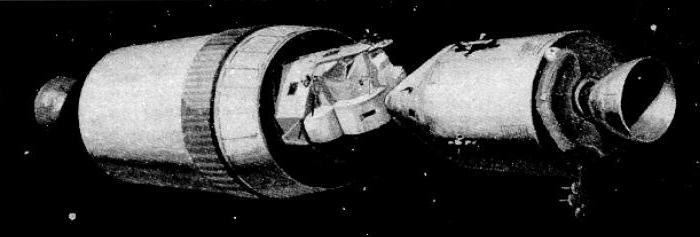 In the documentation of Apollo, the body of the S-IVB is still visible when the CM docks to the LM, and, on the video, we can't see it at all. It is strange that it appears invisible on the video when it is visible on the illustration. It should be visible, for it receives the light from the CM, so at least a part of it should be visible, it should not be completely invisible. |
Especially when we can see debris flying now and then in the video, which proves that the CM can light them. So, if the CM can light these debris, why can't it light at all the body of the saturn rocket which is behind the LM? |
The problem is that the LM starts growing when it is still near the bottom of the image whereas the center of the LM is close to the right top corner of the image in the end. |
If the camera is located over the line of sight of the CM, then the center of the LM will always appear in the bottom of the image when the CM is aligned with the LM. |
Likewise, if the camera is located under the line of sight of the CM, then the center of LM will always appear in the top of the image when the CM is aligned with the LM. |
This animation shows what we should have seen: The LM first appearing close to the top right corner of the image before starting to grow. |
The fact that the LM starts to grow when it is still near the bottom of the image, whereas its center is close to the right top corner of the image at the end of the docking, means that the CM started to move toward the LM before it was aligned with the latter. |
 The fact that the abnormal behavior of the LM on the image could come from a disajustment of the camera is to exclude, for we always see the same (dark blue) bit of the window's side on the image; I have outlined it in red. We see it at the beginning of the video... |
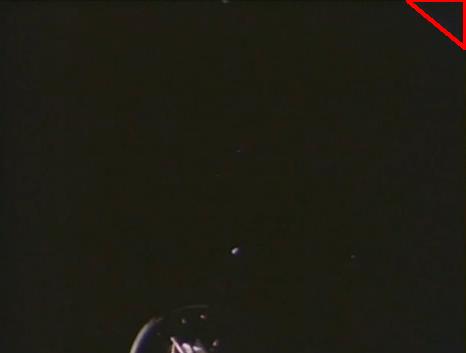 ...We see it at the middle of the video... |
 ...and we see it at the end of the video. |
Normally the CSM should finish its flipover and be perfectly aligned with the LM before starting to move toward the LM if it wants to have a maximum of chance to dock correctly. |
If the CSM starts moving toward the LM before it is well aligned with the latter and goes on turning to get aligned with the LM while it moves forward, it will have more difficulty to dock correctly, and it requires a tighter control, which I doubt that the primitive computer of the CM was able of. Why is better for the CSM to get properly aligned with the LM before starting to move? Because that way the CSM has all its time to find the good alignment with the LM, and, when it moves, it can safely dock with the LM; on the other hand, if the CSM starts to move before it is aligned with the LM, that means it will have to finish the alignment before it meets with the LM; if it does not succeed to obtain the good alignment in time, it will bump incorrectly into the LM and the docking will fail. It is obvious that, if the docking had been real, the CSM would have chosen the safer procedure, and not one which might potentially fail! |
In fact, it is not just the fact that the LM starts to grow when it is not yet on the right position on the video, it is more than that. It is outright the fact that the way the LM appears on the video is globally incoherent. |
When the CSM makes its flipover to show its nose to the LM, it can do in the orbital plane; if it turns counterclockwise, the CSM will have a nice view of the earth when it turns; if it turns clockwise, it won't see the earth. |
But the CSM can also do its flipover in a plane perpendicular to the orbital plane; however, in this plane the CSM won't see the earth. These are not the only possible rotational planes for the CSM; in fact the CSM can have any orientation relatively to its lengthwise axis; thence the rotational plane of the CSM when it makes its flipover can have any orientation. |
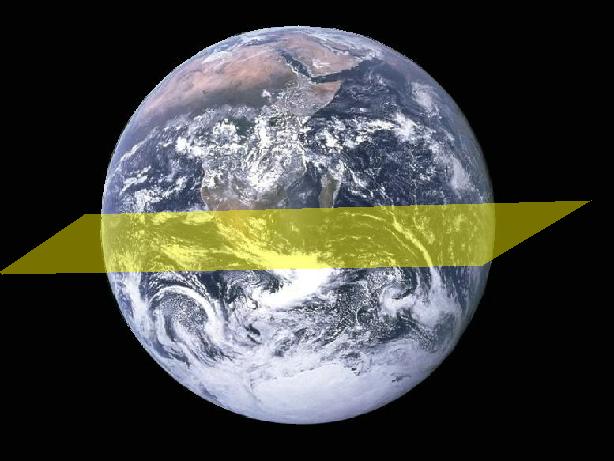 The rotational plane of the CMS may be parallel to the orbital plane. |
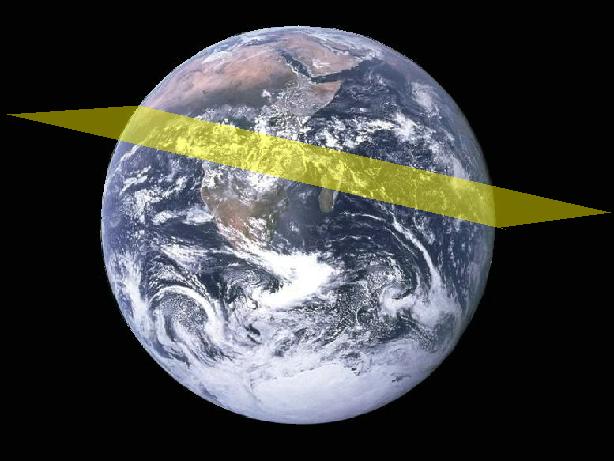 But it can also be ascending relatively to the orbital plane. |
 And it can also be descending relatively to the orbital plane. |
 The CSM has two sets of lateral engines perpendicular to each other (the CSM I show here comes from Apollo 11). That means that the rotational plane can be in the plane of vision of the camera, but also perpendicular to it. Moreover the lateral engines can fire in both directions, which allows the CSM to turn in both directions. I represent the camera so that it is well visible (oversized and outside the CSM). In fact we can have different cases that I am going to present. |
 1.a) The horizontal of the image seen by the camera can be parallel to the rotational plane and the vertical of the image oriented positively relatively to the rotational plane. In the case that the rotational plane is parallel to the orbital plane, the CSM will look like this... |
...And the camera will see the earth this way. |
 1.b) The horizontal of the image seen by the camera still being parallel to the rotational plane and the vertical of the image oriented positively relatively to the rotational plane, but the rotational plane being ascending relatively to the orbital plane, the CSM will look like this... |
...And the camera will see the earth this way. At the end of the flipover, the LM will appear near the left bottom corner of the image. |
 1.c) The horizontal of the image seen by the camera still being parallel to the rotational plane and the vertical of the image oriented positively relatively to the rotational plane, but the rotational plane being descending relatively to the orbital plane, the CSM will look like this... |
...And the camera will see the earth this way. At the end of the flipover, the LM will appear near the left top corner of the image. |
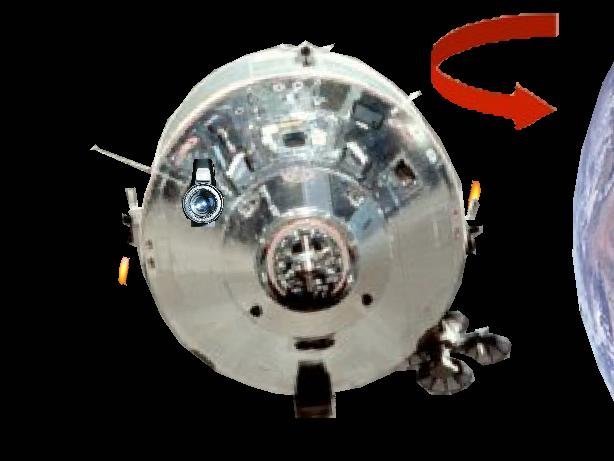 2.a) The horizontal of the image seen by the camera is still parallel to the rotational plane, but the vertical of the image is now oriented negatively relatively to the rotational plane. In the case that the rotational plane is parallel to the orbital plane, the CSM will look like this... |
...And the camera will see the earth this way. |
 2.b) The horizontal of the image seen by the camera still being parallel to the rotational plane and the vertical of the image oriented negatively relatively to the rotational plane, but the rotational plane being ascending relatively to the orbital plane, the CSM will look like this... |
...And the camera will see the earth this way. At the end of the flipover, the LM will appear near the right top corner of the image. |
 2.c) The horizontal of the image seen by the camera still being parallel to the rotational plane and the vertical of the image oriented negatively relatively to the rotational plane, but the rotational plane being descending relatively to the orbital plane, the CSM will look like this... |
...And the camera will see the earth this way. At the end of the flipover, the LM will appear near the right bottom corner of the image. |
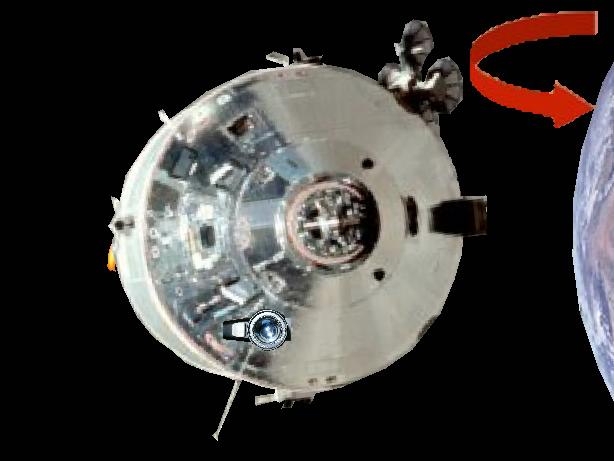 3.a) The horizontal of the image seen by the camera is now perpendicular to the rotational plane, and the vertical of the image turned clockwise relatively to the vertical of the rotational plane. In the case that the rotational plane is parallel to the orbital plane, the CSM will look like this... |
...And the camera will see the earth this way. |
 3.b) The horizontal of the image seen by the camera still being perpendicular to the rotational plane, and the vertical of the image turned clockwise relatively to the vertical of the rotational plane, but the rotational plane of the CSM being ascending relatively to the orbital plane, the CSM will look like this... |
...And the camera will see the earth this way. At the end of the flipover, the LM will appear near the right bottom corner of the image. |
 3.c) The horizontal of the image seen by the camera still being perpendicular to the rotational plane, and the vertical of the image turned clockwise relatively to the vertical of the rotational plane, but the rotational plane of the CSM being descending relatively to the orbital plane, the CSM will look like this... |
...And the camera will see the earth this way. At the end of the flipover, the LM will appear near the left bottom corner of the image. |
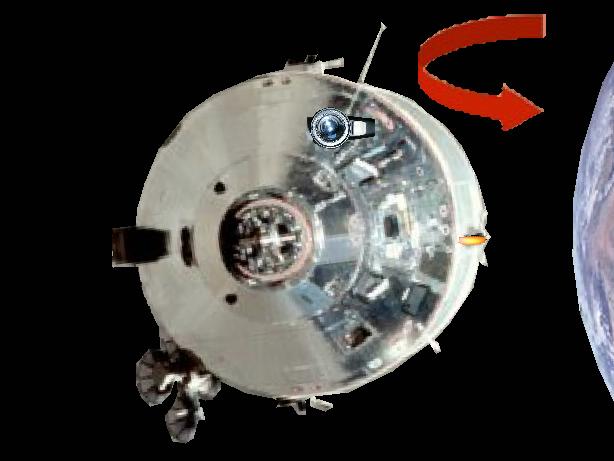 4.a) The horizontal of the image seen by the camera is perpendicular again to the rotational plane, but the vertical of the image is turned counterclockwise relatively to the vertical of the rotational plane. In the case that the rotational plane is parallel to the orbital plane, the CSM will look like this... |
...And the camera will see the earth this way. |
 4.b) The horizontal of the image seen by the camera still being perpendicular to the rotational plane, and the vertical of the image turned counterclockwise relatively to the vertical of the rotational plane, but the rotational plane being ascending relatively to the orbital plane, the CSM will look like this... |
...And the camera will see the earth this way. At the end of the flipover, the LM will appear near the left top corner of the image. |
 4.c) The horizontal of the image seen by the camera still being perpendicular to the rotational plane, and the vertical of the image turned counterclockwise relatively to the vertical of the rotational plane, but the rotational plane being descending relatively to the orbital plane, the CSM will look like this... |
...And the camera will see the earth this way. At the end of the flipover, the LM will appear near the right top corner of the image. |
So, by examining the earth on the Apollo video, it is possible to know both how the rotational plane of the CSM was oriented relatively to the orbital plane, and also how the camera is oriented relatively to the rotational plane of the CSM. |
Of all the animations I have showed, the one I show on the right of this stereoscopic animation is the closest one to the Apollo video (the axis of the camera makes in fact a slight angle with the axis of the lateral engines, but we can ignore it). |
 It corresponds to the horizontal of the image seen by the camera being perpendicular to the rotational plane, and the vertical of the image turned clockwise relatively to the vertical of the rotational plane, and also the rotational plane of the CSM being ascending relatively to the orbital plane. In this view, the LM appears near the right bottom of the image, like I said it when I talked about this case. |
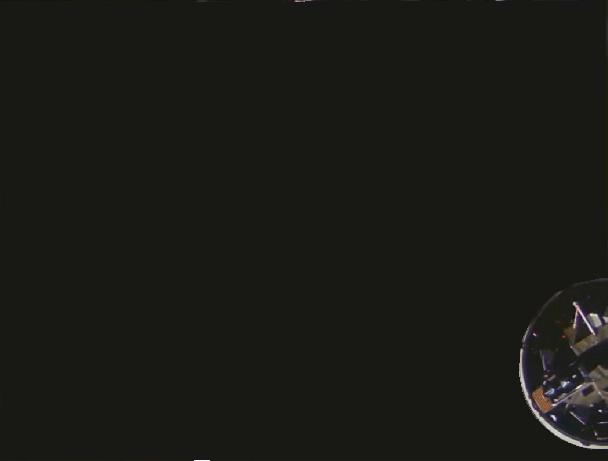 That means that, on the video, the LM should start to appear near the right bottom of the image (not necessarily where I show it in this example, but somewhere near this corner). |
Based on this analysis, I have made an animation which shows how the LM should appear in the video of Apollo. |
And I also turned this animation at a quarter of turn clockwise to show how the camera would see the scene it it was oriented in the rotational plane of the CSM. |
 Another anomaly is that the part I show with a red arrow on these two top views of the LM appears differently on the two views. The view of the left is extracted from a photo of the Apollo 14 mission (AS14-74-10206), and the view of the right is an image of the docking video. On the view of the left, the part I show is obviously the same matter as what is around it. But, on the view of the right, this part appears completely differently, it appears metallic, a bright metal. |
 And, when we see it closer, it makes me think of a piece of armor of a knight of the middle age! |
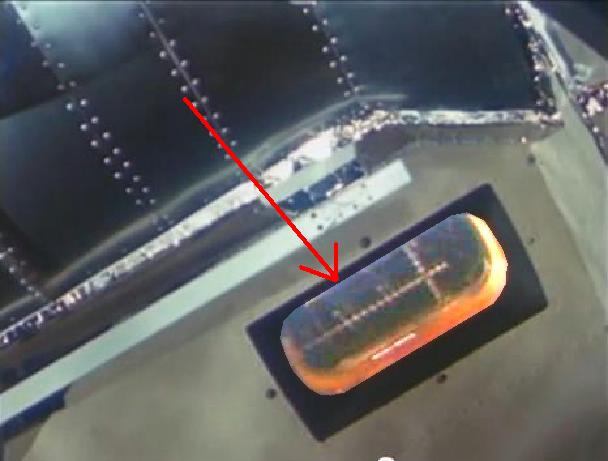 And also, what is this strange thing I have highlighted and that I show with an arrow??? |
 The thing I have surrounded in red is not a normal item of the LM; it is alien to it. It looks like a bell. |
 And this other thing I have surrounded in red is also alien to the LM. |
 On the video, we can also see a strange behavior of two symmetrical metallic bars I have circled on this image of the video. |
On this part of the video (accelerated), we can see that these bars progressively retract themselves, till to become completely hidden. How can this happen? These are not a telescopic bars! Where do they find the place to retract? How do they do not to bump into each other? |
After having seen these anomalies, I clearly call this video BULLSHIT! It is just to make dream some fans of space travel about a fact which in fact never happened. |